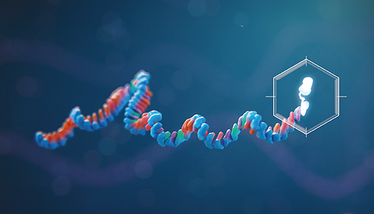mRNA: Cap to the Future
Meet our Innovation Awards runner up: TriLink BioTechnologies’ CleanCap M6 mRNA capping technology – an improved version of the technology used in Pfizer/BioNTech COVID-19 vaccines.
| 4 min read | Interview

The Medicine Maker 2023 Innovation Awards (check out the 2023 showcase here) were fiercely competitive. From AI accelerators and nanoparticle analysis to cell therapy robots and microfluidic chips, the level of technological innovation resulted in a very close race for Grand Winner. Lonza’s Enprotect capsules took the crown, but our runner up was TriLink BioTechnologies’ CleanCap M6 mRNA capping technology.
With mRNA vaccine technology emerging from the pandemic as an outstanding success, the ancillary markets and supply chains that support this exciting modality are ripe for innovation. mRNA must be capped, but traditional capping methods can cause issues with low capping efficiency, high immunogenicity, or a lengthy and expensive process. TriLink developed a method to overcome these challenges, whilst simultaneously improving protein expression and saving manufacturing costs. Here, we speak with TriLink’s Senior Director of Chemistry R&D, Chunping Xu, to learn more.

Chunping Xu
How did the COVID-19 change the company?
When the pandemic hit, we were well-positioned to assist in the global fight by scaling up our flagship CleanCap technology. The technology’s materials were a critical part of the Pfizer/BioNTech vaccines. Subsequently, we have invested heavily in large-scale commercial GMP mRNA cap production and custom mRNA services, so that we can support the future growth of the mRNA revolution. Of note, we also had the honor of supplying mRNA materials that were foundational to the work of 2023 Nobel Prize Laureates Katalin Kariko and Drew Weismann.
Why do mRNAs need to be capped?
A mature mRNA must have a cap to maintain stability and avoid immediate degradation by cellular nucleases. An uncapped mRNA would be rapidly degraded within the cell and would also stimulate a strong innate immune response – both of which adversely impact RNA-based therapeutics. Also, this type of cap structure can help cells differentiate between self-RNA and non-self RNA, which is important for mRNA stability and reactogenicity. Additionally, the mRNA cap plays a critical role in translation into proteins by binding to translation initiation factors.
What are the benefits of the CleanCap technology?
Prior to the invention of CleanCap technology, the mRNA field was using MCAP or anti-reverse cap analog (ARCA) methods for co-transcriptional mRNA capping, which normally results in poor-quality mRNA. With that in mind, we developed CleanCap technology to address the low mRNA capping efficiency and low IVT yield issues associated with ARCA. As an additional benefit, our technology also offers a more streamlined and cost-effective capping process compared with enzymatic capping by enabling very high-quality RNA combined with the benefits of manufacturing efficiency.
The CleanCap M6 analog significantly improves mRNA translation, and we have observed a more than over 30 percent increase in protein expression. In the context of mRNA therapeutic applications, more potent mRNA means that a lower dose is needed to achieve the same efficacy with potentially fewer side effects.
What inspired the development?
Since its launch in 2017, our CleanCap technology has been used extensively to cap mRNA both for research and clinical programs. Published literature, specifically from the Jaffrey lab at Cornell University, reported that m6A modifications can impact mRNA stability. We were keen to further investigate the impact of such modifications on mRNA activity and the resulting immune response. Over many years, TriLink’s dedicated R&D group developed and screened more than 80 cap analogs with various modifications. Following extensive screening, CleanCap M6 analog demonstrated multiple beneficial attributes. To provide these benefits to mRNA researchers, CleanCap M6 was made available as a product in 2023, and has significantly and consistently enhanced the expression of various mRNA constructs, leading to improved protein translation.
What were the biggest challenges in development?
A major challenge in developing new cap analogs is the complex analytical evaluation of the resulting mRNA. Once a novel cap is incorporated into mRNA, we must develop in-house assays to evaluate the mRNA protein translation, mRNA stability, and the immune response both in vitro and in vivo. There is significant complexity in developing the analytical panel for each individual analog.
What future capping developments can we expect?
TriLink continues to focus on mRNA cap analog innovation. Cap analogs with various modifications are currently being investigated and developed. Novel capping technologies for saRNA are another area of interest in RNA therapeutics. We certainly aim to appear on future editions of The Medicine Maker’s Innovation Awards with further mRNA capping innovations!



















